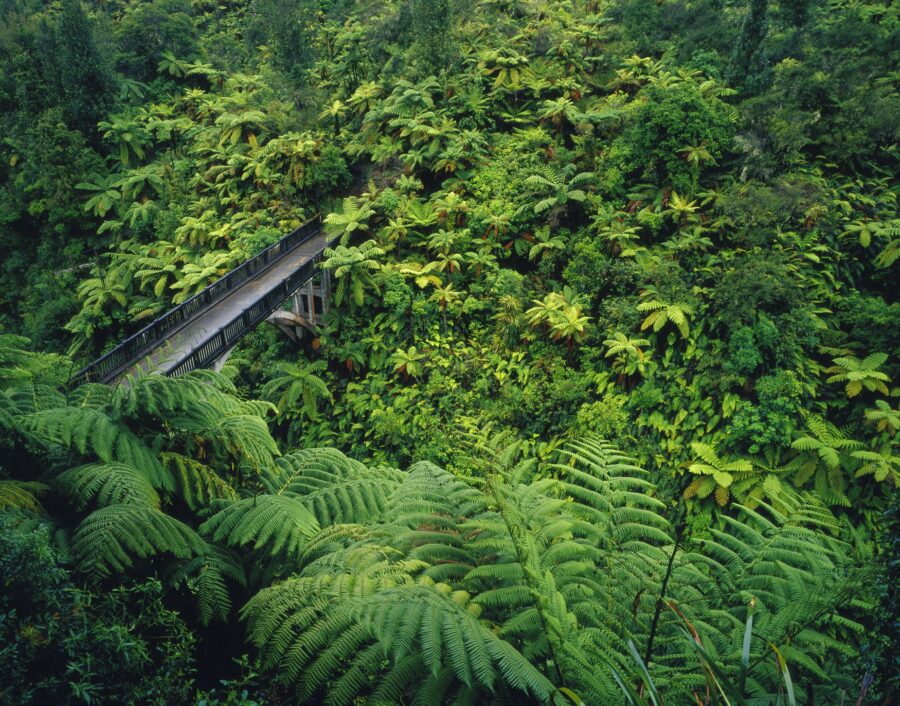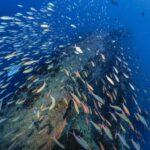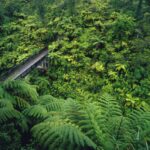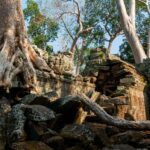When people move out, wildlife moves in: 10 abandoned places reclaimed by nature
Nov 21, 2023, 1:25 PM

The "Bridge to Nowhere" in Mangapurua Valley. Mandatory Credit: agefotostock/Alamy Stock Photo
(CNN) — Wildlife is under unprecedented threat from human activity, but research suggests that given space and time, even animal and plant species on the brink of extinction can bounce back.
A 2022 report commissioned by the non profit Rewilding Europe found many European bird and mammal species were making a comeback, “highlighting the propensity for wildlife to rebound and recolonize when given the opportunity.”
Sometimes, that opportunity can be as simple as humans leaving a place to be reclaimed by nature. All over the world, from temple ruins overrun with tree roots to former war zones bustling with new ecosystems, there are striking examples of nature proving that once humans move out, wildlife has the opportunity to move in.
Ta Prohm, Cambodia
Used as a backdrop in Angelina Jolie’s 2001 movie “Lara Croft: Tomb Raider,” this temple is located east of Angkor Thom, an ancient capital of the Khmer Empire.
Built in the late 12th century as a Buddhist monastery and university, over 12,500 people lived around and served the temple, with 80,000 more in the neighboring villages. The temple and surrounding forested areas were abandoned three centuries later, when the king moved the capital of the empire away from Angkor.
Since then, the temple has been left largely untouched, allowing trees to grow throughout the complex, the most Instagram-famous being the gigantic fig, banyan and kapok trees whose roots envelope the temple walls and tower over visitors.
According to global environmental group Wildlife Alliance, animals thrived in the forests surrounding Angkor before over-hunting and illegal trade in the last century seriously reduced populations, leaving behind just small numbers of common species including muntjac deer, wild boar and leopard cats.
In response, Wildlife Alliance, along with Cambodian government bodies, have reintroduced a number of animals to Angkor since 2013, including pileated gibbons, silvered langurs, smooth-coated otters, hornbills and endangered green peafowls.
Houtouwan, Shengshan Island, China
It once housed a population of over 3,000 residents, but its remote location, over five hours travel to the mainland, made it hard to access education, jobs and food. People started moving out in the 1990s and by 2002, the village was completely abandoned.
Once a bustling fishing village, Houtouwan on Shengshan Island, part of the Zhoushan Archipelago, now looks like a post-apocalyptic ghost town.
It once housed a population of over 3,000 residents, but its remote location, over five hours travel to the mainland, made it hard to access education, jobs and food. People started moving out in the 1990s and by 2002, the village was completely abandoned.
Decades of disuse have allowed nature to reclaim the land, with lush green climbing plants blanketing everything that was left behind.
Today, the village is a popular tourist destination, welcoming over 90,000 visitors in 2021, according to local news reports.
Mangapurua Valley, New Zealand
After the First World War, land in the Mangapurua Valley on New Zealand’s North Island, was offered to soldiers returning from military service. Opened in 1919, at its height the settlement saw almost 40 soldiers and their families try to make a life on the land.
But the valley’s remoteness and poor farming soils meant that by the mid 1940s it was completely abandoned, allowing the forest to grow back and native animals to return.
Now, all that remains as proof of the settlement is the concrete “Bridge to Nowhere” that leads to nothing except wildlife. Everything else, including homes, farms, culverts and the Mangapurua Road, has been reclaimed by the forest, and is part of the Whanganui National Park.
Past farming and gardening efforts by soldiers and their families has meant a lot of the forest in the Mangapurua Valley is now grass and marsh land, with a few fruit and rose trees which reflect a bygone era.
The wider Whanganui National Park houses New Zealand’s largest population of North Island brown kiwi, and supports a range of bird species including grey warblers, robins, silvereyes and bellbirds. The Whanganui River holds 18 fish species including eels, freshwater crayfish and black flounders.
Steam Ship Yongala, Australia
After more than a century on the sea floor, Australia’s largest and most intact shipwreck, the SS Yongala, has become an ecosystem, providing a habitat for some of the ocean’s most magnificent fauna.
In 1911, one year before the Titanic sailed, Cyclone Yasi sunk SS Yongala in the Great Barrier Reef marine park, causing all 122 passengers and crew to be lost to sea. It was one of the most tragic maritime disasters in Australian history, and after an initial seven-day search turned up empty, the ship went undiscovered until being identified in 1958.
Today, the remains of the 109-meter-long wreck are carpeted with brightly colored coral, and are home to hundreds of different species, from loggerhead turtles and marble rays to bull sharks and moray eels.
Ilha da Queimada Grande, Brazil
Located off the coast of Sao Paulo in south-eastern Brazil is an island surrounded by cliffs and covered by low tropical forest and grassland. But if you think it sounds like an ideal holiday destination, the local wildlife might change your mind.
Though small, Ilha da Queimada Grande is home to the world’s highest concentration of golden lancehead snakes, estimated at about 2,000, earning it the nickname of Snake Island. Apart from the snakes, the island fauna includes bats, lizards, two resident passerine birds (the house wren and bananaquit), as well as the many migratory birds and seabirds, like the brown booby, that visit the island.
Marcio Martins, a professor of ecology at the University of São Paulo, told CNN that the island had once been a part of the Brazilian continental shelf, but falling and rising sea levels caused it to be completely isolated by seawater approximately 11,000 years ago. Unable to leave, the golden lancehead adapted to local conditions.
At the start of the 20th century, the island was inhabited by three or four lighthouse watchmen and sailors but has been abandoned since the 1920s.
Today, the island is owned by the Brazilian government and is a protected Area of Relevant Ecological Interest. To maintain its ecosystem and to protect people, it is illegal to visit the island without permission.
Having visited and stayed on the island for research during the ‘90s and 2000s, Martins describes the island as a “biological treasure.”
Demilitarized Zone, Korea
Seventy years since the end of the Korean War, the 160-mile (257-kilometer) demilitarized zone (DMZ) dividing North and South Korea has remained a no-man’s land.
Once a center of conflict, and still littered with former villages and military hardware, the lack of human interference has allowed the land to slowly become a wildlife haven.
The area is now a thriving home to over 6,000 plant and animal species. Of Korea’s 267 endangered species, 38% live in the DMZ, according to the National Institute of Ecology. These include the Mongolian racerunner lizard, which lives on the sandbanks and beneath rocks, otters which swim along the river running between North and South Korea, endangered musk deer, and the Manchurian trout which has its largest habitat there.
Since 2019, 11 peace hiking trails, ranging from 1 to 5 kilometers, have opened along the DMZ as a way to “return the DMZ to the people.” But despite efforts to establish peace, relations between North and South Korea have worsened in recent years.
Al Madam Village, UAE
When you imagine nature taking over, green is probably the first color you think of. But in the village of Al Madam, nature comes in yellow.
Located 70 kilometers (43 miles) from the city of Dubai, in the United Arab Emirates, Al Madam is a mini ghost town, which in recent years has become something of a tourist attraction.
Featuring two rows of furnished homes and an elegant mosque, the town looks like it was abandoned in a hurry, leaving behind settlements that are now being reclaimed by the desert.
While much of its story is shrouded in mystery, according to media reports the village was built in the 1970s as part of a public housing project for Bedouin people, a group of indigenous Arab tribes who historically inhabited desert regions. Before being abandoned just two decades later, the village reportedly housed approximately 100 people.
There is no definitive answer to why the village was abandoned but researchers point to the rise of cities like Dubai and Sharjah, where people went in search of better opportunities and easier living conditions.
Now, the once-loved buildings are slowly disappearing under the unforgiving wilderness.
Fukushima, Japan
The Great East Japan Earthquake and consequent tsunami in 2011 triggered the world’s second worst nuclear disaster, at the Fukushima power plant in northern Japan.
In the days following, the Japanese government created the 12.5-mile (20-kilometer) Fukushima Exclusion Zone, and more than 150,000 residents were forced to evacuate their homes. Since then, evacuation orders have steadily been lifted, and people encouraged to move back to some towns and villages. But some areas remain off-limits for people to live.
While you might imagine nuclear disaster zones to be wastelands devoid of life, research suggests otherwise. James Beasley, professor of forestry and natural resources at the University of Georgia in the US, said in a 2016 TED talk that there was an “incredible diversity of animals” in the exclusion zone, adding that the population of wild boar was so large that it had “become necessary to control their populations in parts of the exclusion zone.”
Other animals that have flourished in the area include Japanese macaques, common raccoon dogs, Japanese serow and red foxes.
St Kilda, Scotland
Over 60 kilometers (37 miles) west of the Outer Hebrides off Scotland’s north-west coast lies the most remote part of the British Isles. From giant cliffs and exceptional sea stacks to clear waters and submerged caves, the St. Kilda island archipelago is an impressive natural beauty.
Long home to a fluctuating population of residents, in 1930, following food shortages, lack of proper access to medical care, and a dwindling population, the remaining 36 islanders requested to be resettled onto the mainland.
Without human activity, St. Kilda has become a wildlife hotspot, and a place of ecological interest, home to almost 1 million seabirds, including the UK’s largest colony of Atlantic puffins. The islands, consisting of Hirta, Boreray, Dun and Soay, are now wildlife sanctuaries, with UNESCO World Heritage Site status.
The islands also feature a unique type of wren, and a sub-species of mouse which is twice the size of the British fieldmouse. The island of Boreray, and surrounding sea stacks, host the world’s largest colony of gannets, and all Soay sheep in the world are descended from those found on Soay island.
Stack Rock Fort, Wales
Located off the Pembrokeshire coast in west Wales, stands a time capsule in the form of a long-abandoned island fort.
Built in the 1850s to protect against an invasion by sea, Stack Rock Fort originally housed several guns, troops and officers, but its use waned over the years. During World War I it was manned by a small number of soldiers and was eventually disarmed in 1929.
Since untouched for almost 100 years, the fort has been slowly reclaimed by flora and fauna.
The new custodian of the fort, Nicholas Mueller, director of community interest company Anoniiem, which has bought the fort and plans to maintain it as a “living ruin,” told CNN that hazel plants grow there, and seabirds are also common, including at least three types of gulls with populations between 300 and 500 on the fort at any one time.
Mueller said regular visitors to the fort include a couple of grey seals. Large black cormorants have set up a colony on the fort and can often be spotted perched with their wings held out.
The-CNN-Wire™ & © 2023 Cable News Network, Inc., a Warner Bros. Discovery Company. All rights reserved.


















